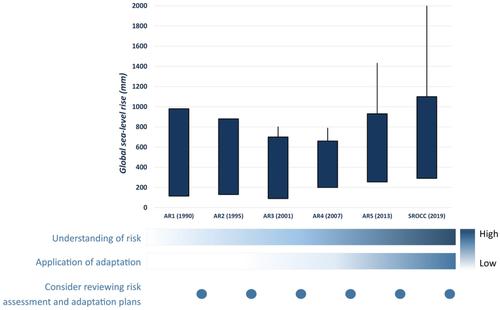当前位置:
X-MOL 学术
›
WIREs Clim. Chang.
›
论文详情
Our official English website, www.x-mol.net, welcomes your
feedback! (Note: you will need to create a separate account there.)
Integrating new sea‐level scenarios into coastal risk and adaptation assessments: An ongoing process
WIREs Climate Change ( IF 9.4 ) Pub Date : 2021-03-22 , DOI: 10.1002/wcc.706 Robert J. Nicholls 1 , Susan E. Hanson 2 , Jason A. Lowe 3, 4 , Aimée B. A. Slangen 5 , Thomas Wahl 6 , Jochen Hinkel 7 , Antony J. Long 8
WIREs Climate Change ( IF 9.4 ) Pub Date : 2021-03-22 , DOI: 10.1002/wcc.706 Robert J. Nicholls 1 , Susan E. Hanson 2 , Jason A. Lowe 3, 4 , Aimée B. A. Slangen 5 , Thomas Wahl 6 , Jochen Hinkel 7 , Antony J. Long 8
Affiliation

|
The release of new and updated sea‐level rise (SLR) information, such as from the Intergovernmental Panel on Climate Change (IPCC) Assessment Reports, needs to be better anticipated in coastal risk and adaptation assessments. This requires risk and adaptation assessments to be regularly reviewed and updated as needed, reflecting the new information but retaining useful information from earlier assessments. In this paper, updated guidance on the types of SLR information available is presented, including for sea‐level extremes. An intercomparison of the evolution of the headline projected ranges across all the IPCC reports show an increase from the fourth and fifth assessments to the most recent “Special Report on the Ocean and Cryosphere in a Changing Climate” assessment. IPCC reports have begun to highlight the importance of potential high‐end sea‐level response, mainly reflecting uncertainties in the Greenland/Antarctic ice sheet components, and how this might be considered in scenarios. The methods that are developed here are practical and consider coastal risk assessment, adaptation planning, and long‐term decision‐making to be an ongoing process and ensure that despite the large uncertainties, pragmatic adaptation decisions can be made. It is concluded that new sea‐level information should not be seen as an automatic reason for abandoning existing assessments, but as an opportunity to review (i) the assessment's robustness in the light of new science and (ii) the utility of proactive adaptation and planning strategies, especially over the more uncertain longer term.
中文翻译:

将新的海平面情景纳入沿海风险和适应性评估:一个持续的过程
需要在沿海风险和适应性评估中更好地预期新的和更新的海平面上升(SLR)信息的发布,例如政府间气候变化专门委员会(IPCC)评估报告中的信息。这要求对风险和适应性评估进行定期审查并根据需要进行更新,以反映新信息,但保留早期评估中的有用信息。在本文中,提供了有关可用的SLR信息类型的最新指南,包括有关海平面极限的信息。政府间气候变化专门委员会所有报告中标题变化范围的比较表明,从第四次和第五次评估到最新的《气候变化中的海洋和冰冻圈特别报告》有所增加“ 评估。IPCC的报告已开始强调潜在的高端海平面应对措施的重要性,主要反映了格陵兰/南极冰盖组成部分的不确定性以及在方案中如何考虑这一不确定性。这里开发的方法是实用的,并将沿海风险评估,适应计划和长期决策视为一个持续的过程,并确保尽管存在很大的不确定性,但仍可以做出务实的适应决策。结论是,不应将新的海平面信息视为放弃现有评估的自动原因,而应作为一个机会来审查(i)根据新科学评估评估的稳健性,以及(ii)主动适应气候变化的实用性和规划策略,尤其是在更不确定的长期计划中。
更新日期:2021-04-23
中文翻译:

将新的海平面情景纳入沿海风险和适应性评估:一个持续的过程
需要在沿海风险和适应性评估中更好地预期新的和更新的海平面上升(SLR)信息的发布,例如政府间气候变化专门委员会(IPCC)评估报告中的信息。这要求对风险和适应性评估进行定期审查并根据需要进行更新,以反映新信息,但保留早期评估中的有用信息。在本文中,提供了有关可用的SLR信息类型的最新指南,包括有关海平面极限的信息。政府间气候变化专门委员会所有报告中标题变化范围的比较表明,从第四次和第五次评估到最新的《气候变化中的海洋和冰冻圈特别报告》有所增加“ 评估。IPCC的报告已开始强调潜在的高端海平面应对措施的重要性,主要反映了格陵兰/南极冰盖组成部分的不确定性以及在方案中如何考虑这一不确定性。这里开发的方法是实用的,并将沿海风险评估,适应计划和长期决策视为一个持续的过程,并确保尽管存在很大的不确定性,但仍可以做出务实的适应决策。结论是,不应将新的海平面信息视为放弃现有评估的自动原因,而应作为一个机会来审查(i)根据新科学评估评估的稳健性,以及(ii)主动适应气候变化的实用性和规划策略,尤其是在更不确定的长期计划中。











































 京公网安备 11010802027423号
京公网安备 11010802027423号